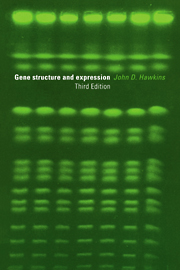Book contents
- Frontmatter
- Contents
- Introduction to the third edition
- Introduction to the second edition
- Introduction to the first edition
- List of abbreviations
- 1 Deoxyribonucleic acid (DNA)
- 2 Ribonucleic acid (RNA)
- 3 Methodology
- 4 Prokaryotic DNA replication and gene expression
- 5 The operon concept
- 6 Eukaryotic gene organisation and replication
- 7 Eukaryotic transcription
- 8 Post-transcriptional processing of RNA
- 9 Oncogenes
- 10 Haemoglobin
- 11 Proteins of the immune system
- 12 Some gene families
- 13 Mitochondrial and chloroplast genomes
- 14 Different and evolving genomes
- Glossary
- Reading lists
- Index
Introduction to the second edition
Published online by Cambridge University Press: 05 June 2012
- Frontmatter
- Contents
- Introduction to the third edition
- Introduction to the second edition
- Introduction to the first edition
- List of abbreviations
- 1 Deoxyribonucleic acid (DNA)
- 2 Ribonucleic acid (RNA)
- 3 Methodology
- 4 Prokaryotic DNA replication and gene expression
- 5 The operon concept
- 6 Eukaryotic gene organisation and replication
- 7 Eukaryotic transcription
- 8 Post-transcriptional processing of RNA
- 9 Oncogenes
- 10 Haemoglobin
- 11 Proteins of the immune system
- 12 Some gene families
- 13 Mitochondrial and chloroplast genomes
- 14 Different and evolving genomes
- Glossary
- Reading lists
- Index
Summary
Since the first edition of this book appeared there have been many advances in our understanding of the genome, so it is opportune to review some of these in this new edition.
New techniques continue to be invented, and those that have come into general use are described in Chapter 4. Chapter 7 on eukaryotic gene organisation and expression has been completely re-written as it is in these fields that some of the most dramatic advances have occurred in the past five years. The chapter on hormone genes has been transmuted into a chapter on gene families since much information is now available about their evolution. In Chapter 12 it has been possible to include new material on chloroplast genomes. Elsewhere there have been some re-arrangements and updating of material.
I am most grateful to Dr Adam Wilkins at CUP who asked me to prepare a new edition and to Dr Paul Lasko of the Department of Genetics at Cambridge University. They have both made some very helpful comments and suggestions after reading the first draft. Dr Robin Smith, also of CUP, saw the final version through the press and also made some valuable suggestions for which I am very thankful.
Finally, I should like to thank colleagues at Barts, especially Professor Gavin Vinson and Dr Ian Phillips, for much encouragement and helpful discussion, and, as ever, my wife for her forebearances while I have been working on the book.
- Type
- Chapter
- Information
- Gene Structure and Expression , pp. xiiPublisher: Cambridge University PressPrint publication year: 1996



